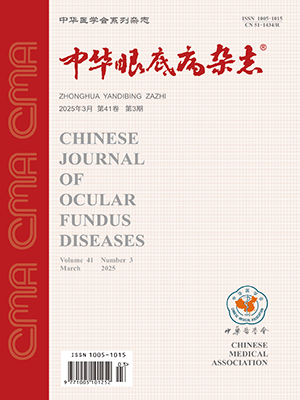| 1. |
Antonetti DA, Klein R, Gardner TW. Diabetic retinopathy[J]. N Engl J Med, 2012, 366(13): 1227-1239. DOI: 10.1056/NEJMra1005073.
|
| 2. |
Kashani AH, Chen CL, Gahm JK, et al. Optical coherence tomography angiography: a comprehensive review of current methods and clinical applications[J]. Prog Retin Eye Res, 2017, 60: 66-100. DOI: 10.1016/j.preteyeres.2017.07.002.
|
| 3. |
Nagaoka T, Sato E, Takahashi A, et al. Impaired retinal circulation in patients with type 2 diabetes mellitus: retinal laser Doppler velocimetry study[J]. Invest Ophthalmol Vis Sci, 2010, 51(12): 6729-6734. DOI: 10.1167/iovs.10-5364.
|
| 4. |
Simo R, Hernandez C. Neurodegeneration in the diabetic eye: new insights and therapeutic perspectives[J]. Trends Endocrinol Metab, 2014, 25(1): 23-33. DOI: 10.1016/j.tem.2013.09.005.
|
| 5. |
中华医学会糖尿病学分会. 中国2型糖尿病防治指南(2017年版)[J]. 中国实用内科杂志, 2018, 38(4): 292-344. DOI: 10.19538/j.nk2018040108.Chinese Diabetes Society. Guidelines for the prevention and treatment of type 2 diabetes in China(2017)[J]. Chinese Journal of Practical Internal Medicine, 2018, 38(4): 292-344. DOI: 10.19538/j.nk2018040108.
|
| 6. |
Agardh CD, Davis M, Lee PP, et al. Proposed international clinical diabetic retinopathy and diabetic macular edema disease severity scales[J]. Ophthalmology, 2003(9): 1677-1682. DOI: 10.1016/S0161-6420(03)00475-5.
|
| 7. |
Carrasco E, Hernández C, de Torres I, et al. Lowered cortistatin expression is an early event in the human diabetic retina and is associated with apoptosis and glial activation[J]. Mol Vis, 2008, 14: 1496-1502.
|
| 8. |
Kern TS, Barber AJ. Retinal ganglion cells in diabetes[J]. J Physiol, 2008, 586(18): 4401-4408. DOI: 10.1113/jphysiol.2008.156695.
|
| 9. |
Ishibazawa A, Nagaoka T, Takahashi A, et al. Optical coherence tomography angiography in diabetic retinopathy: a prospective pilot study[J]. Am J Ophthalmol, 2015, 160(1): 35-44. DOI: 10.1016/j.ajo.2015.04.021.
|
| 10. |
Takase N, Nozaki M, Kato A, et al. Enlargement of foveal avascular zone in diabetic eyes evaluated by en face optical coherence tomography angiography[J]. Retina, 2015, 35(11): 2377-2383. DOI: 10.1097/IAE.0000000000000849.
|
| 11. |
Samara WA, Say EA, Khoo CT, et al. Correlation of foveal avascular zone size with foveal morphology in normal eyes using optical coherence tomography angiography[J]. Retina, 2015, 35(11): 2188-2195. DOI: 10.1097/IAE.0000000000000847.
|
| 12. |
Kim K, Kim ES, Rhee SY, et al. Clinical characteristics and risk factors for retinal diabetic neurodegeneration in type 2 diabetes[J]. Acta Diabetol, 2017, 54(11): 993-999. DOI: 10.1007/s00592-017-1043-5.
|
| 13. |
Samara WA, Shahlaee A, Adam MK, et al. Quantification of diabetic macular ischemia using optical coherence tomography angiography and its relationship with visual acuity[J]. Ophthalmology, 2017, 124(2): 235-244. DOI: 10.1016/j.ophtha.2016.10.008.
|
| 14. |
Chui TY, VanNasdale DA, Elsner AE, et al. The association between the foveal avascular zone and retinal thickness[J]. Invest Ophthalmol Vis Sci, 2014, 55(10): 6870-6877. DOI: 10.1167/iovs.14-15446.
|
| 15. |
Kim K, Kim ES, Yu SY. Optical coherence tomography angiography analysis of foveal microvascular changes and inner retinal layer thinning in patients with diabetes[J]. Br J Ophthalmol, 2018, 102(9): 1226-1231. DOI: 10.1136/bjophthalmol-2017-311149.
|




